Abstract
When observing transboundary waters through the lens of Integrated Water Resources Management (IWRM), it is essential to emphasize the principle of watershed unicity, which must overcome geopolitical interests while being supported by technical criteria. This paper used a multilevel and multiscale approach for integrated management of transboundary water resources in two South American transboundary river basins: the Javari River Basin (between Brazil and Peru) and the Quaraí River Basin (between Brazil and Uruguay). The Food and Agriculture Organization (FAO) provided spatialized data for South American watersheds. Our research focused on several broad issues concerning regional transboundary water management: (a) Because only Peru and Brazil use the Otto–Pfafstetter method, a uniform method within a regional agreement about methodological differences for delimiting hydrographic basins in each country is required; (b) It is necessary to organize accurate databases to avoid problems of mismatched borders by overlapping national databases or mismatches due to scale problems; (c) It is also necessary to establish a coordinating body capable of working with each country’s representatives. In this case, building integrated and collaborative cartographic database becomes critical; (d) Because river meanders can change, historical data of a river’s morphology is required. In this sense, this research provides guidelines to make water management in transboundary rivers feasible in South America.
1. Introduction
On a global scale, water issues have been gaining importance in several dimensions. Water remains a prominent issue on the United Nations (UN) agenda, with two international decades, 2005–2015 and 2018–2028, and one international year, 2013, devoted to it [1].
One of the most pressing concerns is how to manage water resources efficiently as they become scarce. Water, one of the Sustainable Development Goals (SDG) issues, has played a strategic role in the global agenda [2]. Water management, conversely, has become a central topic because it has multiple uses and is relevant at different levels and scales. Because of the complexities of water management, Integrated Water Resources Management (IWRM) has emerged as a method that aims to maximize equitably the economic and social outcomes while preserving vital ecosystems [3,4,5].
In the case of transboundary waters hydric bodies shared by two or more countries, IWRM becomes even more significant and vital. Aquifers, lakes, reservoirs, river basins, large marine ecosystems, and open ocean areas are among the 756 international water systems. More than half of the world’s population depends on water resources shared by two or more countries [6].
When transboundary waters are considered in the context of IWRM, it is possible to understand how complex rivalries between water users are. They reach countries’ foreign affairs, where they become issues of national sovereignty, energy reliance, food production, and disaster avoidance. Although this is a source of contention, the United Nation’s Human Development Report for 2006 indicates worldwide cooperation among nations as the dominant pattern [7]. Based on data from the UN Food and Agriculture Organization, the world history between 805 and 1984 presented more than 2600 treaties about international water resources, and from 1984 to 1998, the records of cooperation reached 1228 cases against 507 cases of conflict, with more than two-thirds being only verbal hostilities [8]. Sixty percent of the listed conflicts were about water quantity and approximately twenty-five percent were about infrastructure. When focusing on cooperation agreements rather than conflicts, it is worth noting that 15% of the agreements aim for shared management [7], emphasizing the role of IWRM. Consequently, sharing concern for in-border environments is a path that countries should take.
To develop cross-border policies on shared natural resources, with water management as the driving force, it is essential to consider the country’s actual internal socio-environmental situation. National regulatory frameworks should develop water management based on the principle of watershed unicity, overcoming geopolitical interests [9,10].
Building integrated and collaborative cartographic bases becomes critical in this context because understanding the terrain leads to good governance at any territorial and temporal scale. Therefore, the purpose of this paper is to propose a multi-level and multi-scale approach to integrated transboundary water resource management, using two South American transboundary river basins as examples: the Javari River Basin (between Brazil and Peru) and the Quarai River Basin (between Brazil and Uruguay).
The majority of spatial or territorial analyses begin with an examination of a single cartographic scale of approach [11]. The same is true for transboundary water issues, which can be addressed by considering how scales affect the nature of treaties: large-scale treaties focus on environmental and institutional development, whereas small-scale treaties focus on allocative rules, hydropower, and flood control. Generally, small-scale treaties are more likely to include quantified water allocation provisions and regulatory goals, whereas large-scale treaties are used to establish mechanisms and procedures for later decision-making [10].
Transboundary water issues, due to their complexities, require a multi-scale approach. Furthermore, data standardization and sharing are required to achieve the numerous goals of transboundary water management, which range from hydropower and flood control to diplomacy and organizational system development. All data and information must therefore be contained within the same cartographic projection system, albeit at different spatial levels and scales. Consequently, the motivation for this research stems from the need to consider multiple scales simultaneously. Because scale analysis is critical in transboundary water management, all countries should collaborate at various scales [12].
Due to the nature of the phenomena being studied, scientific research is frequently conducted at only one level of analysis, which can be classified as any of the following levels for social studies: (a) Micro–micro; (b) Macro–macro; (c) Micro–macro and d) Macro–micro [13].
This research proposes analyzing hydrographic basins at various integrated scales by focusing on the space-time relationship, beginning with individual demands. For this reason, it is necessary to establish links between global demands and their interactions. This proposal is illustrated in Figure 1.
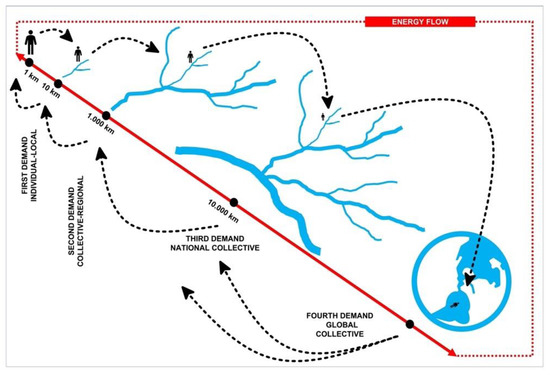
Figure 1.
Multilevel analysis proposal. (Source: authors).
It is possible to approach multi-criteria analysis [14,15,16,17] within a multilevel scale analysis, which builds relationships and actions that inform the agents involved in a decision-making process [18].
2. Materials and Methods
2.1. Study Area
- (A)
- Level 0: River Plate Basin
The River Plate Basin encompasses Argentina, Bolivia, Brazil, Paraguay, and Uruguay, covering over 3.1 million km². This basin is the second largest in South America and the fifth largest in the world. It has a population of about 100 million people, and its water resources are essential for the South American economy [19]. Tucci and Clarke (1998) highlight that environmental pressures on the basin, particularly after the 1970s, are a result of drastic changes in land use and agricultural practices, which have led to increased pollution, runoff, sedimentation, and flooding.
- (B)
- Level 1: Uruguay River Basin
The Uruguay River is the second largest tributary of the River Plate Basin. Its basin flows across Argentina, Brazil, and Uruguay. This basin’s environmental impacts are associated with the discharge of raw sewage from its major urban centers and the widespread use of pesticides in rural areas. Pasture and cropland are the most common land uses. Other significant negative impacts on the basin’s effluent water resources derive from intensive activities related to swine, poultry, and cellulose industries [20].
- (C)
- Level 2: Quaraí/Cuareím River Basin
The Quaraí/Cuareím River is a tributary of the Uruguay River (Figure 2). Brazil and Uruguay share this basin as a natural border. It includes the Brazilian municipalities of Barra do Quaraí, Santana do Livramento, Quaraí, and Uruguaiana, as well as the Uruguayan Department of Artigas. The Quaraí River’s mouth is shared by the municipalities of Barra do Quaraí (Brazil), Bella Unión (Uruguay), and Monte Caseros (Province of Corrientes in Argentina).
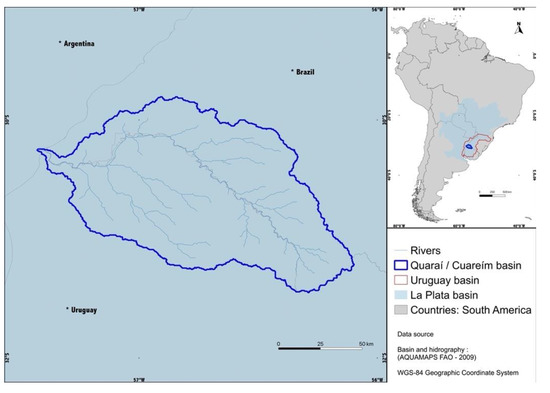
Figure 2.
Location of the Quaraí/Cuareim River Basin.
The floodplains of the Quaraí/Cuareím River Basin are primarily used for grazing and rice irrigation [21]. Water demand has increased due to rice cultivation. Water availability during irrigation months (November to February) has become a limiting factor for rice cultivation over the last few decades [22].
- (A)
- Level 0: Amazon River Basin
The Amazon River Basin is the largest in the world. This basin extends over 6 million km² in Peru, Colombia, Ecuador, Venezuela, Guyana, Bolivia, and Brazil. Its primary tributaries flow from the Andes Mountains and to the Brazilian plains before reaching the Atlantic Ocean [23]. The Amazon River basin is distinguished by its large rivers with extensive floodplains and numerous river islands.
Large-scale deforestation in Brazil has been concentrated primarily in the eastern and southern portions of the Amazon River basin since the 1960s. The economic pressure for deforestation of the Amazon Forest has prompted researchers to study the effects on local and global hydrological cycles [24].
- (B)
- Level 1: Solimões River Basin
The Solimões River is the primary tributary of the Amazon River, integrating the territories of Brazil, Colombia, Ecuador, and Peru and covering 2 million km² (36% of the Amazon River Basin). The vegetation cover in the Solimões River Basin is one of the least degraded in the Amazon [25]. In terms of relief, the remarkably high and rugged regions of the Andes Mountains stand out, reaching more than 6000 m of altitude; it also has a broad plain with extensive flooded areas, located along the Solimões River as its main tributaries (Purus, Juruá, Javari, Japurá), with remarkable seasonality in flooded areas [26].
- (C)
- Level 2: The transboundary Javari/Yavarí River basin
The Javari/Yavarí River is a Solimões River tributary that forms a natural border between Brazil and Peru (Figure 3). This basin includes the Brazilian municipalities of Atalaia do Norte and Benjamin Constant, and the Peruvian cities of Caballococha and Islândia. In Benjamin Constant, the Javari/Yavarí River flows into the Solimões River. There is a triple border between the municipalities of Tabatinga (Brazil), Letícia (Colombia) and Santa Rosa (Peru) near the mouth, separated by two islands called Islândia (Peru) and Petrópolis (Brazil).

Figure 3.
Location of the Javari/Yavarí River Basin.
The Javari/Yavarí River Basin is situated in the middle of the Amazon rainforest. Its rivers are the primary means of transportation and communication for the local population. The basin’s hydrography is the route for Brazilian natural resources across the triple frontier: for example, it is also the route for smuggled Brazilian wood to Peru and fish to Colombia for later resale in other countries of the basin [27]. The rivers of the basin are also used to transport narcotics from Peru and Colombia [28].
2.2. Materials
The database was recovered from governmental websites, known as Geoportal. It covers the official delimitation of the hydrographic basins and drainage stretches, with files available in a spatialized format (shapefile). The metadata, which describes the methodology, year of elaboration, and scale of the downloaded data, is also available in the Geoportal, ensuring the reliability of its information.
Additionally, international sources of watershed data covering South America were used for this research: the Food and Agriculture Organization (FAO) repository provides a Geoportal, which provides spatialized data on hydrographic basins and drainages from around the world. The World Wide Fund for Nature (WWF) and The United States Geological Survey (USGS) collaborated on this data as part of a project called HydroATLAS [29].
2.3. Methods
These databases were analyzed regarding the scale, levels of detail, year, and data preparation methods. The data were then studied for their potential to analyze transboundary basins, either as a complement or by incorporating neighboring territories.
After defining potential databases for analyzing transboundary basins, the chosen basis was characterized by considering the following factors: extent, terrain planimetry, morphometric aspects of the watercourse, and flow direction. QGIS was the software used to perform spatial operations.
3. Results
3.1. Analysis of the Official Databases
The Otto–Pfafstetter method, developed by the Brazilian engineer Otto Pfafstetter, subdivides and codifies basins called Ottobacias using a hierarchical method based on a drainage network’ s topography and topology (connectivity and direction) [30]. The secondary courses and their contributing areas are delimited from the basin’s mouth after delimiting the primary watercourse (coded by a three-digit number in Brazil, according to the National Water and Sanitation Agency (ANA-Brazil) (Figure 4) [31]. Even numbers in the basin code result from the codification of secondary course’ contributing areas (2, 4, 6, and 8). The lowest number (2) is always intended for the largest contributing area. The remaining areas that contribute directly to the main watercourse are called inter-basins, and they are divided at each intersection of the primary and secondary watercourses (green dots in Figure 5). The inter-basin coding is established by adding odd digits (1, 3, 5, 7, and 9) in the upstream direction. These codes are referred to as level 4 because they have four digits. The same procedure is used for each delimited sub-basin to increase level of detail, adding digits to the end of the code until there are no more stretches to encode.
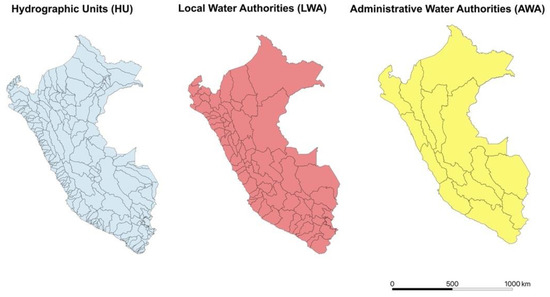
Figure 4.
The Hydrographic Units file (in blue) in Peru contains the files related to Water Resources Management at the local level (in red) and the regional levels (in yellow).
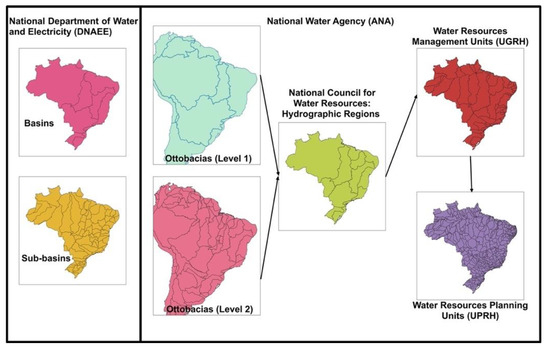
Figure 5.
The basins and sub-basins in Brazil elaborated by DNAEE are portrayed on the right. On the left are the Ottobacias’ derivation of water resources management bases.
The method (also known as Ottobacias) is used to produce the databases in Peru and Brazil, but not in Uruguay (Table 1). Regardless of elaboration, the databases are all recent, with Peru’s being the oldest at 13 years old.

Table 1.
Metadata of the downloaded shapefiles.
The database in Peru is organized by archive basins and sub-basins known as hydrographic units (HU). These HU correspond to the 72 Local Water Authorities (LWA) and, when combined, form the 16 Administrative Water Authorities (AWA) (Figure 4). The LWA and AWA are Peruvian water resource management boundaries at the local (LWA) and regional (AWA) level.
In 1972, the National Department of Water and Electricity (DNAEE) of Brazil created a database for water resource management. Currently, the Otto–Pfafstetter concept of Ottobacias serves as the official base for water resource management. They do not correspond to the specialized basins created by DNAEE (Figure 5).
Therefore, the National Water Resources Council (2002) proposed 12 Hydrographic Regions (in green) that correspond to the Ottobacias boundaries (levels 1 and 2). Following the scope of the National Water Resources Plan (2021–2040), ANA-Brazil delimited at the most detailed level 64 Water Resources Management Units-UGRH (in red) and 441 Water Resources Planning Units-UPRH (in purple).
The twelve hydrographic regions (in green) conceptually correspond to the space comprising an adjacent basin or a group of basins or sub-basins with homogeneous or similar natural, social, and economic characteristics, in order to guide national water resources planning and management. Due to Brazil’s vast territory, this aggregation level is ineffective at individualizing all regional specificities required for the National Water Resources Plan, which includes statistics, indicators, and derived analyses.
Within the National Water Resources Council’s scope, based on Ottobacias, ANA-Brazil proposed 64 UGR (in red—Figure 6) to stratify the national territory in order to prepare the Water Resources Situation Report (within the National Water Resources Plan from 2021 to 2040). Similarly, at a more detailed level, ANA-Brazil prepared the UPRH to subsidize the definition of a minimum coverage area for the development of municipal or state plans, aiming at national integration. However, as previously stated [32], database incompatibility can jeopardize the policy transversality and integration at different levels.
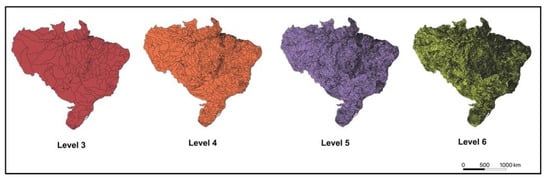
Figure 6.
Brazilian hydrographic basins (Ottobacias) in cross-border view.
This method is used by ANA-Brazil to make hydrographic basin data for South America available (at levels 1 and 2 with fewer details). In comparison to the other bases, ANA-Brazil offers a smaller mapping scale (1:1,000,000) for cross-border countries at other levels (3, 4, 5, and 6), as indicated in the figure below.
In turn, the National Water Agency of Peru (ANA-Peru) provides data for its territory and for the extension of transboundary basins on a scale of 1:100,000, as indicated in the following Figure 7.
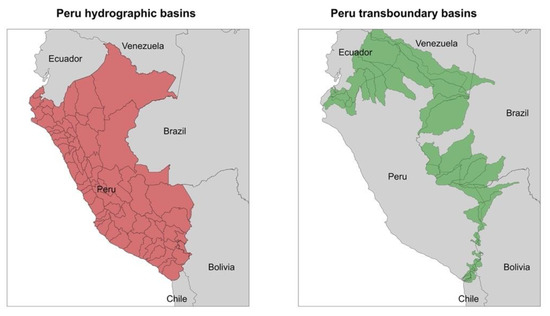
Figure 7.
Peruvian hydrographic basins. The country’s borders are depicted in red. Its transboundary basins are depicted in green.
Uruguay, due mainly to its smaller territorial extent, provides hydrographic basin data derived from topographic maps at a detailed scale of 1:50,000, produced by its military geographic service (SGM). In contrast, the detail level is restricted to Uruguayan territory, making this the only analyzed database that does not provide cross-border data (Figure 8).

Figure 8.
Uruguayan hydrographic basins in five levels of detail.
3.2. Complementarity of Transboundary Basin’ Data
The most feasible way to analyze the transboundary basins would be to combine the databases from each country and use geoprocessing techniques to assess the physical characteristics of each basin (extension, topographic profile, digital elevation model, etc.). However, when analyzing the two transboundary basins for this case study, three issues were discovered, making this complementary analysis impossible.
The first issue stems from the different methodologies used to delimit hydrographic basins. The Otto–Pfafstetter method is not used in Uruguay, but it is in Peru and Brazil. An analysis between Brazil and Peru is possible because they use the same delimitation methodology; however, other South American countries do not use the Otto–Pfafstetter method, making an analysis impossible.
The second issue concerns the mapping scales. Data in Brazil ranges at 1:1,000,000, while data in Peru ranges at 1:100,000. This disparity (a factor of 10) prevents more detailed inferences, particularly on the Brazilian side. It is possible to consider using transboundary basin data from official databases in Peru and Brazil, but the level of detail of the transboundary basin is inconsistent.
The third issue, as observed in the visual overlap analysis, is the level of detail. The levels of detail in the Otto–Pfafstetter method result in extreme variations in size/delimitation for the analyzed basins when using Brazil’s transboundary basin database for both study basins (Quaraí and Javari).
With this knowledge, an experiment of the data at level 5 was conducted, allowing for the visualization of six sub-basins in the Javari River, while the Quaraí River Basin was subdivided into at least sixty-seven sub-basins (Figure 9). Lowering the level from 5 to 4 revealed that the Javari/Yavarí River Basin is oversized (it agglutinates neighboring basins such as the Juruá River basin), whereas the Quaraí River Basin retains nine sub-basins. Finally, when the experiment was reduced to level 3, the real delimitation of the Quaraí River was discovered. Simultaneously, the Javari/Yavarí River Basin flows into the great Solimões River Basin.
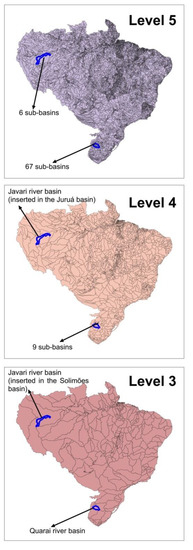
Figure 9.
Brazilian Ottobacias (levels 5, 4, and 3) and case study basins.
Generally, the analyses indicate that the average size of polygons does not decrease proportionally as the level of the basins rises. As a result, it is impossible to find a level that accurately identifies the analyzed basins. The Javari/Yavarí River Basin appears oversized in Peru’s cross-border data (Figure 10), indicating that it is included in a polygon with other basins. These problems may eventually lead to conflicting border limits, which can be identified as mismatched borders in the overlapping national databases.
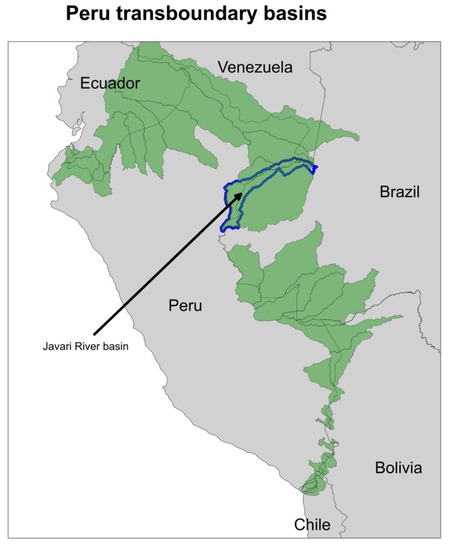
Figure 10.
Peru’s transboundary basins. In blue, lines that delimit the Javari River basin.
Additionally, it is worth mentioning the absence of complementary alphanumeric data. The name of the basin or its primary river’s name is one of the factors to consider when determining transboundary basin delimitations. Data from Peru and Uruguay is well described, demonstrating the basin area in addition to these names; however, alphanumeric data from Brazil has only one coding for each polygon (Figure 11).

Figure 11.
Alphanumeric data referring to Ottobacias (Brazil—level 2).
Because there are no names, it is necessary to establish a coordinating body capable of working with each country’s representative to create an articulated database. As a result, it will provide a better management of South America’s transboundary waters.
Another issue was discovered during a literature review on the Amazonian transboundary sub-basins: while there are no scientific or political concerns regarding Brazil and Peru’s borders, the borders of Javari/Yavarí River demonstrate a striking natural characteristic that constantly changes the river’s course, creating two different positions of the border for each country, particularly in regions with no human occupation [33]. Figure 6 portrays a section of the Javari/Yavarí River with its current bed and remnants of its previous bed to demonstrate how the river’s course changes (Figure 12).
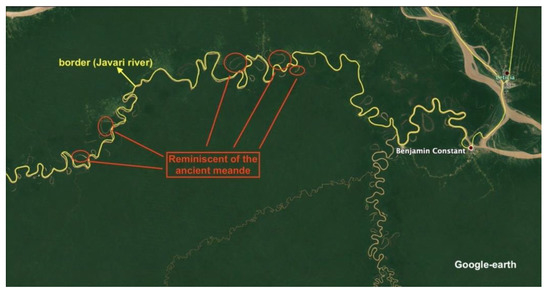
Figure 12.
Reminiscent signs of the ancient meanders of Javari River.
When border treaties between Brazil and Peru were investigated, there was no prediction of what should be done if the riverbed changed. Therefore, the following questions remain: What does it look like in this situation? Does Brazil or Peru have a defined policy for this issue? It could be surmised that it depends on Brazilian and Peruvian foreign policy and the creation of new treaties between these two countries [34].
4. Discussion
Given the impossibility of working with official data in a complementary manner, the solution for conducting a transboundary basin analysis is to search for databases from international bodies or institutions. Aside from ensuring the origin of the data (via the Metadata files), it is critical to ensure that the previously discussed issues do not become a limiting factor when selecting databases. The ideal delimitation for the database would be South America, which would eliminate methodological and scale differences.
Following the identification of the delimitation of South America, another critical factor is determining the level of detail compatible with the now-known record for the mapped units. Finally, alphanumeric data is another factor that contributes to identify hydrographic basins quickly. This data includes a brief description of the basin’s name or its primary rivers’ name, for example.
The Food and Agriculture Organization (FAO) repository makes spatialized data from South American watersheds available in a geoportal called Aquamaps, which was consulted after the mentioned definition of specific criteria.
The hydrographic basins provided by FAO are derived from the HydroAtlas project [29], which was performed by the WWF in partnership with international institutions and projects (EU BioFresh project, International Union for Conservation of Nature—IUCN, and McGill University) using the USGS topographic data.
The HydroAtlas basins were created using the Otto–Pfafstetter method (derived from SRTM/USGS data with 15 arc seconds). Consequently, the delimitation method produces 12 files of spatialized watersheds (at 12 levels of detail) for each of the world’s continents. The FAO was responsible for implementing the method and Aquamaps made it available by generating a single file for each continent’s primary hydrological basins and sub-basins (Figure 13).
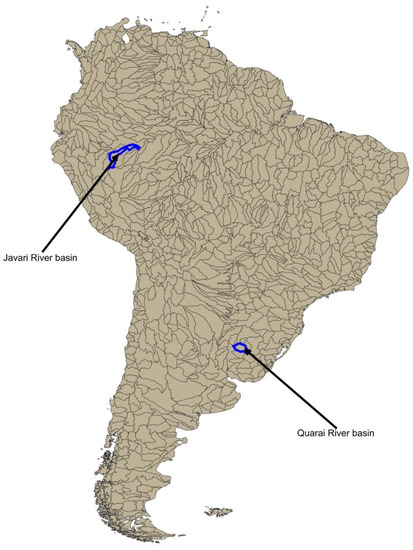
Figure 13.
Basins and sub-basins available at Aquamaps (FAO).
This single file provides continuous coverage of uniform-sized sub-basins. The names of the central basin and sub-basin are available in alphanumeric data, making them easier to find and select (Figure 14).
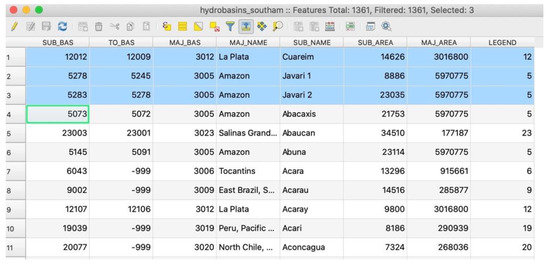
Figure 14.
Alphanumeric data for basins and sub-basins available at Aquamaps (FAO).
Sub-basin segmentation adheres to the primary method of dividing each location where two river arms meet. Setting a criterion for each sub-basin in a specific area upstream of at least 100 km2 guarantees homogeneity in sub-basins sizes (polygons). Thus, the sub-basin product is hierarchically nested and supported by the Otto-Pfafstetter coding method, allowing for a global comparison analysis of hydrographic basin topology.
As this is a multiscale analysis, this database only provides information at the most basic and detailed levels, such as the Quaraí River Sub-basin and the Rio de la Prata Basin, as well as the Javarí/Yavarí River Sub-basin and River Amazonas Basin. Nonetheless, the intermediate level can be analyzed using drainage stretches derived from hydrographic basins made available by the FAO, which assist in the selection of sub-basins that comprise these basins’ intermediate level (Figure 15).
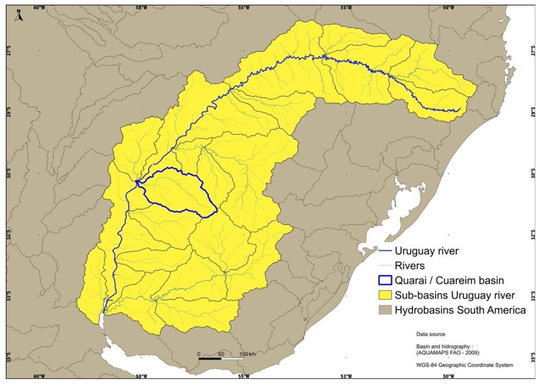
Figure 15.
Selection (in yellow) of Uruguay River sub-basins.
The FAO database allows a multiscale analysis of South American transboundary basins for academic purposes and physical watershed analysis. Official data is essential for the purpose of Integrated Water Resources Management because it provides specificities and information that can be applied at the local, regional, and national levels. Therefore, international workgroups must perform the geospatial information complementarity (hydrographic basins and drains). Local, regional, and national specificities must be aggregated to hydrographic basin standard cartographic elements (scale, projection, datum, levels detailing, and alphanumeric data), allowing robust transnational analyses. As crucial as standardizing this database is, it is also crucial to make it available for free, with easy access and aiming for greater collaboration in the use and verification of this data, while broadening its applicability.
Finally, the proposal is to establish a South American coordinating body for transboundary waters. This goal of this coordinating body is to create an articulated database between the countries involved. Some regional governmental efforts have been made to discuss transboundary basin issues, such as the I International Symposium of Transboundary Waters in Latin America (2018) and the II International Symposium of Transboundary Waters in Latin America (2022). This coordination group should emerge from these governmental discussions so that it can be adopted as official regional policy by the South American governments. Additionally, as part of the preparatory framework for the the 2023 World Water Conference, regional water sector organizations such as the Global Water Partnership-South America, and the additional support of the Regional Group of Experts on Water Resources of Latin America and the Caribbean of the United Nations, should be included.
The first step of the integrated database should be to develop a standard scale that would apply to all participating countries while still respecting each country’s water management strategies. The proposed common scale would be 1:100,000, which is the scale used for the official delimitation of Peru’s hydrographic base and considers the difficulties in carrying out this delimitation in the Amazon. Detailing at this scale level in Amazon may not be effective because it contains the largest hydrographic basins and bodies of water of the world in addition to the lowest demographic densities.
This coordinating body should also detect and correct articulations between countries so that their letters (based on alphanumeric data) do not cause gap errors or overlap. Finally, this continental coordinating body should define a basin coding system. Because different methodologies are used to delimit hydrographic basins, we propose expanding the Otto–Pfafstetter method with careful review to level 3, where we can conclude that true delimitation can be discovered while avoiding river basin is oversizing.
Working with these three levels as a multiscale database can help structure multilevel management and support decision making and planning at the national, regional, and local levels. Finally, a well-established coordination body with a strong and accurate cartographic database can aid in natural border disputes by removing cartographic components from the dispute.
5. Conclusions
Through a case study of two basins in a multiscale level analysis, this study addressed some general issues concerning regional transboundary water management. The following were the conclusions:
- A coordinating body capable of working with each country’s representatives and idiosyncrasies is required to build an articulated database and make transboundary basin management in South America more feasible. The primary goal of this coordinating body would be to develop a standard method and scale that would apply to all patriating countries while respecting each country’s unique water management strategies. The Otto–Pfafstetter method is recommended here, with a common scale of 1:100,000 structured in three hierarchical levels.
- Accurate database organization is required to avoid problems such as mismatched borders caused by overlapping national databases or scale issues. Accuracy also includes the presentation of complementary alphanumeric data (such as basin names or the names of its main rivers) to aid in the identification of transboundary basins delimitations.
- Historical data on river morphology is required because river meanders can change, affecting country borders and national surface area in a specific water basin.
Furthermore, regional transboundary cooperation begins with the principle of cooperation and the desire to cooperate. Countries and their respective foreign policies should look beyond geopolitics and narrow national interests to embrace a broader perspective of shared future and sustainable development.
In view of the discussion presented throughout the investigation, and the results presented, this work contributes to collaborating with water resource managers at different scales of approach in South America and points to the innovative character of treating water as a natural resource that overlaps with the merely traditional geopolitical aspects.
Author Contributions
Conceptualization: V.A.S., C.H.S. and G.E.P.; methodology: V.A.S., G.E.P., C.H.S. and R.G.P.d.S.; software: R.G.P.d.S.; validation: V.A.S. and C.H.S.; formal analysis: V.A.S., C.H.S. and G.E.P.; investigation: V.A.S., C.H.S., G.E.P. and R.G.P.d.S.; resources: V.A.S., C.H.S., G.E.P. and R.G.P.d.S.; data curation: R.G.P.d.S. and G.E.P.; writing—original draft preparation: V.A.S., C.H.S. and G.E.P.; writing—review and editing: V.A.S., C.H.S. and G.E.P.; visualization: G.E.P.; supervision: V.A.S.; project administration: V.A.S.; funding acquisition: V.A.S. All authors have read and agreed to the published version of the manuscript.
Funding
This research was funded by Global Water Partnership South America and the APC was funded by the Department of Geography of the University of Brasilia.
Institutional Review Board Statement
Not applicable.
Informed Consent Statement
Not applicable.
Data Availability Statement
Not applicable.
Acknowledgments
Alejandra Mujica Sallés (Regional Coordinator of GWP-SA) and Leandro Raul Diaz [President of GWP-SA during the project period (2020–2021)].
Conflicts of Interest
The authors declare no conflict of interest.
References
- Saito, C.H. Quais seriam as Questões Globais que desafiam a Educação Ambiental? Para além do modismo, uma análise sistemática e uma visão sistêmica. REMEA-Rev. Eletrôn. Mestr. Educ. Ambient. 2017, 1, 4–24. [Google Scholar] [CrossRef]
- Sadoff, C.W.; Borgomeo, E.; Uhlenbrook, S. Rethinking water for SDG 6. Nat. Sustain. 2020, 3, 346–347. [Google Scholar] [CrossRef]
- Bouwer, H. Integrated Water Management for the 21st Century: Problems and Solutions. J. Irrig. Drain. Eng. 2002, 128, 193–202. [Google Scholar] [CrossRef]
- Falkenmark, M. Water resilience and human life support—Global outlook for the next half century. Int. J. Water Resour. Dev. 2020, 36, 377–396. [Google Scholar] [CrossRef]
- Global Water Partnership. Towards Water Security: A Framework for Action; GWP: Stockholm, Sweden, 2000. [Google Scholar]
- UNEP. Transboundary Waters Systems—Status and Trends: Crosscutting Analysis; United Nations Environment Programme (UNEP): Nairobi, Kenya, 2016. [Google Scholar]
- UNDEP. Human Development Report 2006; UNDEP: New York, NY, USA, 2000. [Google Scholar]
- Wolf, A. Conflict and cooperation along international waterways. Water Policy 1998, 1, 251–265. [Google Scholar] [CrossRef]
- Steinke, V.A.; Hessel, F.D.O.; Saito, C.H. Considerações sobre o Brasil e a geopolítica das bacias hidrográficas transfronteiriças. Geosul 2013, 28, 89. [Google Scholar] [CrossRef]
- Steinke, V.A.; Saito, C.H. Priority wetlands for conservation of waterbird´s diversity in the Mirim lagoon catchement area (Brazil-Uruguay). Pan-Am. J. Aquat. Sci. 2013, 8, 221–239. [Google Scholar]
- Budds, J.; Hinojosa, L. Restructuring and rescaling water governance in mining contexts: The co-production of waterscapes in Peru. Water Altern. 2012, 5, 119–137. [Google Scholar]
- Norman, E.S.; Bakker, K. Transgressing Scales: Water Governance Across the Canada–U.S. Borderland. Ann. Assoc. Am. Geogr. 2009, 99, 99–117. [Google Scholar] [CrossRef]
- Rokkan, S. The comparative study of political participation: Notes toward a perspective on current research. In Essays on the Behavioral Study of Politics; Ranney, A., Ed.; Urbana: University of Illinois, IL, USA, 1962; pp. 47–90. [Google Scholar]
- Bana e Costa, C.A. Readings in Multiple Criteria Decision Aid; Bana e Costa, C.A., Ed.; Springer: New York, NY, USA, 1990. [Google Scholar]
- Maystre, L.; Pictet, J.; Simos, J. Méthodes Multicritères ELECTRE—Description, Conseils Pratiques et Cas d’Application à la Gestion Environnementale; Presses Polytechniques et Universitaires Romandes: Lausanne, Switzerland, 1994. [Google Scholar]
- Munda, G.; Parruccini, M.; Rossi, G. Multicriteria evaluation methods in renewable resource management: Integrated water management under drought conditions. In Multicriteria Analysis for Land-Use Management; Beinat, E., Nijkamp, P., Eds.; Environment & Management; Springer: Dordrecht, The Netherlands, 1998; Volume 9. [Google Scholar] [CrossRef]
- Munda, G. Multi-criteria decision analysis and sustainable development. In Multiple-Criteria Decision Analysis. State of the Art Surveys; Figueira, J., Greco, S., Ehrgott, M., Eds.; Springer International Series in Operations Research and Management Science; Springer: Berlin/Heidelberg, Germany, 2005; pp. 953–986. [Google Scholar]
- Roy, B. Méthodologie Multicritère d’Aide à la Décision; Ediciones Economica: Barcelona, Spain, 1985. [Google Scholar]
- Tucci, C.E.M.; Clarke, R.T. Environmental Issues in the la Plata Basin. Int. J. Water Resour. Dev. 1998, 14, 157–173. [Google Scholar] [CrossRef]
- Abreu, R.C.; Cunningham, C.; Rudorff, C.M.; Rudorff, N.; Abatan, A.A.; Tett SF, B.; Dong, B.; Lott, F.C.; Sparrow, S.N. Contribution of Anthropogenic Climate Change to April–May 2017 Heavy Precipitation over the Uruguay River Basin. Bull. Am. Meteorol. Soc. 2019, 100, S37–S41. [Google Scholar] [CrossRef]
- Suertegaray, D.M.A. Deserto Grande do Sul: Controvérsia; Universidade Federal do Rio Grande do Sul Publisher: Porto Alegre, Brazil, 1998. [Google Scholar]
- Calhman, O.K.B.; da Hora, M. Shared management of water resources among sovereign states in Latin America: The case of the River Plate basin. J. Environ. Prot. 2016, 7, 1089–1095. [Google Scholar] [CrossRef][Green Version]
- Goulding, M.; Barthem, R.; Ferreira, E.J.G. The Smithsonian Atlas of the Amazon; Smithsonian Books: Washington, DC, USA, 2003. [Google Scholar]
- Marengo, J.A. On the hydrological cycle of the Amazon Basin: A historical review and current state-of-the-art. Rev. Bras. De Meteorol. 2006, 21, 1–19. Available online: http://mtc-m16b.sid.inpe.br/col/sid.inpe.br/mtc-m15@80/2007/04.23.17.52/doc/Marengo_RBM.pdf (accessed on 5 December 2020).
- Paiva, R.C.D. Modelagem Hidrológica e Hidrodinâmica de Grandes Bacias: Estudo de Caso: Bacia do Rio Solimões. Master’s Thesis, Federal University of Rio Grande do Sul, Porto Alegre, Brazil, 2009. [Google Scholar]
- Hess, L.L.; Melack, J.M.; Novo, E.M.; Barbosa, C.C.; Gastil, M. Dual-season mapping of wetland inundation and vegetation for the central Amazon basin. Remote Sens. Environ. 2003, 87, 404–428. [Google Scholar] [CrossRef]
- Becker, B. Amazônia: Geopolítica na Virada do III Milênio; Garamond: São Paulo, Brazil, 2009. [Google Scholar]
- Balieiro, L.F.d.V.D.; Nascimento, I.R. Tríplice fronteira Brasil, Peru e Colômbia e as implicações com o narcotráfico. Textos Debates 2015, 2, 85–98. [Google Scholar] [CrossRef][Green Version]
- Linke, S.; Lehner, B.; Ouellet Dallaire, C.; Ariwi, J.; Grill, G.; Anand, M.; Beames, P.; Burchard-Levine, V.; Maxwell, S.; Moidu, H.; et al. Global hydro-environmental sub-basin and river reach characteristics at high spatial resolution. Sci. Data 2019, 6, 283. [Google Scholar] [CrossRef] [PubMed]
- Pfafstetter, O. Classificação de Bacias Hidrográficas—Metodologia de Codificação; Departamento Nacional de Obras de Saneamento (DNOCS): Rio de Janeiro, Brazil, 1989. [Google Scholar]
- Agência Nacional de Águas (ANA). Codificação de Bacias Hidrográficas Pelo Método de Otto-Pfafstetter. Agência Nacional de Águas, Brasil. 2014. Available online: https://capacitacao.ana.gov.br/conhecerh/handle/ana/104 (accessed on 10 December 2020).
- Galvão, W.S.; Meneses, P.R. Avaliação dos Sistemas de Classificação e Codificação das Bacias Hidrográficas Brasileiras para Fins de Planejamento de Redes Hidrométricas [Conference paper]. In Proceedings of the Anais XII Simpósio Brasileiro de Sensoriamento Remoto, Goiânia, Brazil, 16–21 April 2005; Available online: http://marte.dpi.inpe.br/col/ltid.inpe.br/sbsr/2004/11.21.01.26/doc/2511.pdf (accessed on 16 December 2020).
- Marinho, B.C. Principais Obstáculos no Combate aos Crimes Ambientais no Rio Javari, na Fronteira Entre Brasil e Peru. Master’s Thesis, State University of Amazonas, Manuas, Brazil, 2016. [Google Scholar]
- Carneiro, D.S. Morfodinâmica Fluvial do Rio Solimões, Trecho Tabatinga a Benjamin Constant—AM e suas Implicações para o Ordenamento Territorial/Deize de Souza Carneiro. Niterói: [s.n.], 2009. 151 f. Dissertação (Mestrado em Geografia). Master’s Thesis, Universidade Federal Fluminense, Rio de Janeiro, Brazil, 2009. [Google Scholar]
Publisher’s Note: MDPI stays neutral with regard to jurisdictional claims in published maps and institutional affiliations. |
© 2022 by the authors. Licensee MDPI, Basel, Switzerland. This article is an open access article distributed under the terms and conditions of the Creative Commons Attribution (CC BY) license (https://creativecommons.org/licenses/by/4.0/).